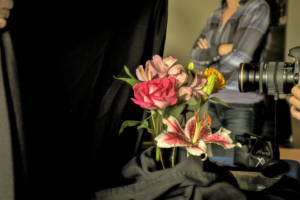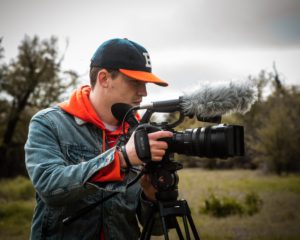Film editors are creative professionals who use film editing techniques to tell stories using video content. They import film footage, organize shots by scenes and takes, and assemble the pieces to create a compelling story.
Essential Film Editing Terms and Techniques
If you want to become an editor, you need to learn some essential film editing terms and techniques.
Continuity Editing
This editing technique creates an ongoing stream of action.
Continuity Error
This type of mistake happens when inconsistent actions or visual elements appear in shots.
Cross-Cutting
This technique gives the appearance that two storylines are happening simultaneously.
Cut
Use cuts to transition from one shot into another.
Cutaway
This technique refers to a shot from another scene interrupting an action shot.
Dissolve
This occurs when the beginning of one shot gradually overlaps the end of another.
Editing
Editing involves choosing and combining film footage to create a complete story.
- Editing ProcessThe film editing process is part of the post-production process and involves either physical film or digital technology.
- Editing TransitionsCross-cuts, fades, dissolves, wipes, and jump cuts are all editing transitions.
- Establishing ShotThis shot shows a location to help viewers understand the scene’s setting.
- Eyeline MatchThis editing technique reveals what the characters see or experience rather than showing the characters themselves.
- FadeWith a fade, visual and audio elements gradually disappear as new ones take over to suggest a new setting or time.
- IrisThis transition involves a circle that increases and then decreases in size.
- J CutsThis editing technique involves playing the audio before the visual aspect.
- Jump CutThis type of cut is sudden and excludes key parts of the action.
L Cut
For an L cut, the audio and visual components change at different rates between shots. Watch this clip from Fight Club:
Here is another example from Skyfall:
Match Cut
This editing technique juxtaposes two shots with similar compositions. Here is an example from 2001: A Space Odyssey:
Here is an example from Lawrence of Arabia:
Montage
A montage is a series of shots that can tell a story or make an emotional impact. Here is a montage from The Good, the Bad, and the Ugly:
Here is an example from the Karate Kid:
Roll
This technique moves text or graphics up or down the screen.
Rough Cut
Essentially a rough draft, this cut is the first draft of a film.
Sequence Shot
This lengthy shot typically lasts for a whole scene.
Shot Reverse Shot
This technique involves alternating over-the-shoulder shots of two characters, usually as they talk with each other.
The Standard
Also known as a hard cut, this type of cut goes from shot to shot without a transition.
Sweetening
This technique involves adding sound effects or music to film.
Wipe
A wipe is a pattern or visual element that appears as one shot transitions into another.
Editing Techniques and Principles for Filmmakers
When you start out in this field, follow these principles of film editing.
Shoot for Editing
Think about editing as the director films a scene, and plan or recommend appropriate shots.
Select the Important Action
When you’re editing, eliminate the fluff, and use shots that tell the story.
Select Just What the Story Needs
Don’t hesitate to leave out great footage if it doesn’t move the story along.
Show Something New With Each Edit
Each cut should reveal a new perspective or additional information.
Vary the Shot Size and Angle
Get creative and avoid cuts between similar shots.
Use Cutaways to Hide Jumpy Edits
If necessary, insert cutaways between similar shots.
Here is another example from Ferris Bueller’s Day Off:
Step Between Shot Sizes
Add a mid shot between a closeup and a long shot for better flow.
Use a Master Shot for an Overview
Establish locations and settings with long shots.
Get the Pace Right
Pace each shot so that viewers can understand it without losing interest.
Use the Right Transitions
Think about the most appropriate transitions you can use to join different shots.
Edit on the Action
Edit during an action, rather than at the start or end of the action, for a smoother scene. Here is an example from the Matrix:
Don’t Cut Moving Shots to Still Shots
Cut from one moving shot to another or from one still shot to another.
Pay Attention to the Sound
Keep sound levels consistent throughout each scene.
Build Your Soundtrack Carefully
Make sure music and sound effects don’t drown out dialog.
Use Sound That Carries Across the Edit
Add ambient background noise to avoid silence, and use J cuts or L cuts for variety.
Keep Track of the Bigger Picture
Make sure each cut contributes to the scene or film as a whole.
Further Viewing: Editing Examples
To understand film editing techniques better, see this invisible art in action.
All That Jazz: The Power of Storytelling Through Editing
This masterpiece of film editing includes several sequences that tell complex stories visually, completely without dialog.
Baby Driver: Cutting to Music
Sound plays a significant role in this film, as each cut is edited to synchronize with sound effects or music.
The Godfather: Juxtaposition
In this film, the editors juxtapose shots of very different scenes, such as a baptism and an assassination, to add new layers of meaning.
Jaws: Editing for Tension
This masterful example shows how editors can create tension by cutting to various perspectives of the action, using increasing speed to elevate this feeling.
Mad Max Fury Road: Editing Action
This film delivers continual, unrelenting action by cutting on movement and keeping the momentum going.
Raging Bull: Capturing Emotional Themes
The Oscar-winning editor of this film created sequences of emotional scenes and action scenes to heighten the viewer’s knowledge of the main character’s inner feelings. Here are a few clips from the movie:
Education and Training: Learning Editing Programs
To become a great film editor, you need a mix of academic and technical knowledge. Watching YouTube videos can help you learn some technical basics, and enrolling in film school can help you gain academic knowledge and get a foothold in the industry.
Form Video Clips to Feature-Film Quality in One Platform
Programs like Adobe Premiere Pro can handle all of your film editing needs. This software does everything from importing and trimming film footage to adding effects.
Do More With After Effects and Adobe Stock
Adobe Premiere Pro is integrated with other products like After Effects and Adobe Stock. With these programs, you can access extra footage and add effects.
Hone Your Post-Production Chops
Practice might not make perfect, but it can enhance your skills. By completing tutorials, you can learn new skills and improve your film editing abilities.
Personality
The best film editors are creative and determined, even when they face difficult situations. They also continuously strive to improve their craft.
Lifestyle
Some film editors have full-time jobs for one production studio, while others work freelance jobs for multiple clients. Many work 40-hour weeks, and some take on additional projects.
Unions, Groups, and Associations
Many film editors join the Motion Picture Editors Guild, a union of post-production film professionals. The Editors Guild also offers networking and development resources.
Employment
Many film editors start out as interns, assistant editors, or production assistants. From there, you can build a network and look for jobs that require more responsibility and skill.
Getting Started
To get started, set up a website and start uploading your work. Download stock footage to get practice editing film and telling stories.
Advancement
Get as much experience as possible to advance your editing skills. Experienced film editors can often choose larger, higher-paying projects.
FAQ
Here are answers to some frequently asked questions about film editing:
What Skills Do You Need?
To excel as a film editor, you need these key skills:
- Creativity
- Editing
- Filmmaking
- Initiative
- Passion
- Eye for detail
What Is Editing?
Editing involves creating a story with your eyes and emotions. Depending on the cuts and techniques you use, the process can include visible and invisible editing.
How Much Does a Film Editor Make?
Film editors make an average annual salary of $52,100. Members of the Editors Guild earn rates based on the union’s scale. Are you interested in a career in film editing? Learn more about the Cinema Production Program at NFI today.














